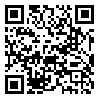Fri, Nov 28, 2025
Volume 13, Issue 3 (9-2024)
2024, 13(3): 19-25 |
Back to browse issues page
Download citation:
BibTeX | RIS | EndNote | Medlars | ProCite | Reference Manager | RefWorks
Send citation to:



BibTeX | RIS | EndNote | Medlars | ProCite | Reference Manager | RefWorks
Send citation to:
Ostovarrad F, Dadgaran I, Tabari R, Taheri F, Peyrovi Z, Rahmanpanah S. Comparison of Caries Detection Ability among Dental Students in Two Methods of In-Person and Combined (In-Person and Virtual) Training before and during the Covid-19 Pandemic. Journal title 2024; 13 (3) :19-25
URL: http://3dj.gums.ac.ir/article-1-615-en.html
URL: http://3dj.gums.ac.ir/article-1-615-en.html
Farzane Ostovarrad1 

 , Ideh Dadgaran2
, Ideh Dadgaran2 
 , Rasool Tabari3
, Rasool Tabari3 
 , Farnaz Taheri4
, Farnaz Taheri4 
 , Zahra Peyrovi1
, Zahra Peyrovi1 
 , Sina Rahmanpanah *5
, Sina Rahmanpanah *5 




 , Ideh Dadgaran2
, Ideh Dadgaran2 
 , Rasool Tabari3
, Rasool Tabari3 
 , Farnaz Taheri4
, Farnaz Taheri4 
 , Zahra Peyrovi1
, Zahra Peyrovi1 
 , Sina Rahmanpanah *5
, Sina Rahmanpanah *5 


1- Department of Oral and Maxillofacial Radiology, School of Dentistry, Guilan University of Medical Sciences, Rasht, Iran
2- Medical Education Research Center, Education Development Center, Guilan University of Medical Sciences, Rasht, Iran
3- Social Determinants of Health Research Center, Guilan University of Medical Sciences, Rasht, Iran
4- School of Dentistry, Guilan University of Medical Sciences, Rasht, Iran
5- Department of Oral and Maxillofacial Radiology, School of Dentistry, Guilan University of Medical Sciences, Rasht, Iran ,Cena.rahmanpanah@gmail.com
2- Medical Education Research Center, Education Development Center, Guilan University of Medical Sciences, Rasht, Iran
3- Social Determinants of Health Research Center, Guilan University of Medical Sciences, Rasht, Iran
4- School of Dentistry, Guilan University of Medical Sciences, Rasht, Iran
5- Department of Oral and Maxillofacial Radiology, School of Dentistry, Guilan University of Medical Sciences, Rasht, Iran ,
Abstract: (634 Views)
Introduction: Since 2020, the world's educational system has been encountered with some problems due to the Covid-19 pandemic and the impossibility of holding classes. The aim of the present study was the comparison of two learning methods of in-person and combined (in-person and virtual) in caries detection ability among dental students before and during covid-19 pandemic.
Materials and Methods: This study was a cross-sectional-analytical research performed on the population of dentistry students who had passed the practical radiology courses as in-person or combined training (n=25). Ten digital bitewing radiographs were given to students to diagnose the presence/absence of caries and if there was, a diagnosis of caries depth. The students' diagnosis was recorded in a special researcher-made checklist and the answers were evaluated based on false and true. SPSS and descriptive statistics and analytical tests at the level of P<0.05 were used to analyze the data.
Results: Students in the In-person education group correctly detected the presence or absence of caries in 89% of cases, while this number was 83.75% in the group of combined education students(P<0.001). Also, students who were in the In-person education group correctly detected the depth of caries in 78.9% of cases, while this number was 70.6% in the group of combined education(P<0.050).
Conclusion: According to the findings of this study, virtual education, if it replaces In-person education, reduces the ability of students in the field of radiographic interpretation of dental caries. The use of combined and virtual education requires improving the infrastructure and reviewing traditional teaching methods.
Materials and Methods: This study was a cross-sectional-analytical research performed on the population of dentistry students who had passed the practical radiology courses as in-person or combined training (n=25). Ten digital bitewing radiographs were given to students to diagnose the presence/absence of caries and if there was, a diagnosis of caries depth. The students' diagnosis was recorded in a special researcher-made checklist and the answers were evaluated based on false and true. SPSS and descriptive statistics and analytical tests at the level of P<0.05 were used to analyze the data.
Results: Students in the In-person education group correctly detected the presence or absence of caries in 89% of cases, while this number was 83.75% in the group of combined education students(P<0.001). Also, students who were in the In-person education group correctly detected the depth of caries in 78.9% of cases, while this number was 70.6% in the group of combined education(P<0.050).
Conclusion: According to the findings of this study, virtual education, if it replaces In-person education, reduces the ability of students in the field of radiographic interpretation of dental caries. The use of combined and virtual education requires improving the infrastructure and reviewing traditional teaching methods.
Type of Study: Original article |
Subject:
Radiology
Received: 2024/10/23 | Accepted: 2024/11/20 | Published: 2024/10/1
Received: 2024/10/23 | Accepted: 2024/11/20 | Published: 2024/10/1
Send email to the article author
| Rights and permissions | |
 | This work is licensed under a Creative Commons Attribution-NonCommercial 4.0 International License. |

